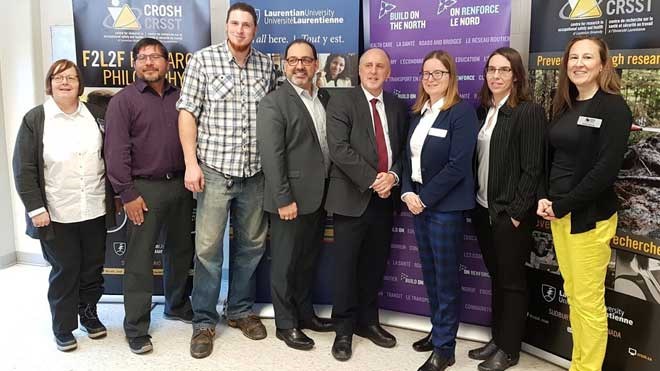Laurentian University’s Centre for Research in Occupational Safety and Health (CROSH) in Sudbury will receive more than $300,000 in new research funding from the Ontario government.
Ontario’s Minister of Energy and Sudbury MPP Glenn Thibeault made the announcement at the CROSH lab on Jan. 16.
Ontario is awarding a total of $310,000 to support innovative research projects and top talent.
The funding will assist CROSH researchers as they carry out three projects aimed at addressing mobile equipment hazards, advancing Indigenous occupational health and safety in Northern Ontario and improving safety for people who work around heavy equipment.
The grants include:
$182,000 through the MOL Occupational Health and Safety Prevention Innovation Program to support the project Development of Knowledge Transfer Kits to Address Mobile Equipment Hazards.
Project lead: Dr. Tammy Eger
Project aims: To develop three Knowledge Transfer Kits to address the following hazards related to the operation of mobile equipment: 1) Line-of-sight and situational awareness, 2) Exposure to vibration, and 3) Fatigue and musculoskeletal disorders. The KTKs are designed to be used by occupational health and safety trainers in the workplace.
$68,000 through the MOL Research Opportunities Program: Research for the Workplace to support the project Mino-nokiiwin: Advancing an Understanding of Indigenous Occupational Health and Safety in Northeastern Ontario
Project leads: Dr. Nancy Lightfoot and Dr. Darrel Manitowabi
Project aims: In the Ojibwa language, mino-nokiiwin refers to a good working environment. This project will identify factors that compromise and contribute to mino-nokiiwin in Indigenous communities.
$59,000 through the MOL Research Opportunities Program: Evidence for Practice to support the project Improving line of sight knowledge for pedestrians working around heavy equipment
Project lead: Dr. Alison Godwin
Project aims: To develop and test a line-of-sight virtual reality intervention aimed at improving line-of-sight awareness and knowledge for workers who move around heavy equipment on a daily basis at work.
These research projects were evaluated through a rigorous peer review process involving academic and industry experts and were chosen based on their research excellence and societal benefits for Ontarians, said a press release.
They build on the innovative research already underway at CROSH and foster new discoveries to support best practice in the workplace.
“Addressing high hazards associated with the operation of mobile equipment was a priority identified in the 2015 Mining Health Safety and Prevention review,” said Thibeault, in the release.
“Furthermore, addressing Indigenous workplace issues will begin a conversation about what is needed to improve occupational health and safety of Indigenous peoples in the workplace."
CROSH research chair Tammy Eger and director Sandra Dorman said they believe these funds will help drive the development and implementation of the centre’s research and innovation strategy.
They also underscore the province’s commitment to the long-term sustainability of the only occupational health and safety research centre addressing the specific research needs of Northern Ontario.




